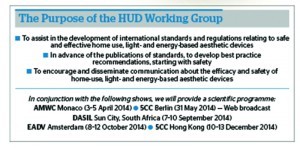Embedded lasers: Class 1C
Home-use laser products have ‘Accessible Emission Limits’ from ‘embedded’ lasers that would result ordinarily in them having laser hazard classifications of Class 3R, 3B or 4, but because of interlocks and design features cannot emit hazardous radiation when the product is not in contact with the skin. With no ‘free’ emission control measures, current standards do not make much sense. The IEC has therefore defined a new laser category, Class 1C, in its draft revisions to IEC standard 60825-1 (Ed.3 Safety of laser products – Part 1: Equipment classification and requirements), which may be applied to the laser products that are being marketed for skin treatments in the home.
The latest IEC 60825 Committee Draft ‘parent’ standard, while specifying the requirements for a Class 1C laser, clearly states that if an applicable IEC (‘daughter’) standard specifying engineering controls to prevent emission into the surrounding space or to the eye does not exist, then classification to laser Class 1C is not permitted. Typical Class 1C laser products would embrace those intended for home-use hair removal, skin wrinkle reduction, and acne reduction.
The IEC has also started to draft a vertical standard IEC 60335-2-xx (Household and Similar Electrical Appliances – Safety – Part 2-xx Particular requirements for cosmetic and beauty therapy appliances incorporating lasers and intense light sources), which anticipates the new laser classification wording contained in the future IEC 60825-1 Ed.3, and provides the necessary design features, engineering controls, interlocks, skin pigment detection, and suitable user instructions to ensure safe use by a consumer.
The invention of the laser Class 1C opens the market for new products being offered by manufacturers of cosmetic light-based appliances, thus ‘enabling’ them. This seems to make sense, since the laser appliances otherwise classified laser Class 3B or 4 would be regarded as being very hazardous to the eyes (which they are not when interlocked) and hence suffer from strong regulation of their use.
In similar cases, such as UV-emitting devices, in some countries national regulation comes into play. However, lasers and intense light sources discharging in the visible and infrared spectrum present no risk of cancer as compared with malignancy-provoking UV sources. The worst effect of visible and infrared light is skin burns, which might include blistering. Although some adverse event cases may require medical care, most of them will heal over time. Permanent effects may comprise scarring and hyper/hypopigmentation. Although this risk seems tolerable, eye injury as a result of non-functioning safeguards or misuse of the equipment is a serious concern. Apparently, there are only a few reports available about incidents of any type in the home-use area, although many hundreds of thousands of units have already been sold. This should not prevent those who are concerned from collecting data and evaluating the true risks.
Regulation outside the EU and USA
International efforts continue to develop consistency in regulatory frameworks, and as in the EU and the US, regulatory controls usually include a three-tiered approach:
- Pre-market assessment, assuring quality and safety for sale
- In-market monitoring of advertising, claims and labelling
- Post-market surveillance, to check adverse events and ensure continuing safety in use.
While Australia and New Zealand treat home-use light-based devices in a similar way to other household electrical appliances, as in the EU, no clear pattern is seen in most other world markets.
Japanese manufacturers produce significant numbers of home-use laser and intense light devices, which are both exported and actively sold in the domestic market. However, the regulatory position of such devices in Japan is at best ambiguous, with strong opinions expressed by professional interest groups about whom should use light-based devices such as lasers, but are not backed by any visible statutory framework or guidelines from government ministries. Despite many anecdotal reports of adverse events in the media and at national medical conferences, between 1999 and 2003 there were only seven complaints to the Consumers’ Center of the Tokyo Metropolitan Government about home‑use laser hair removal devices.
Conclusions
We are dealing with a new and fast emerging market, worth multi-millions of dollars every year. This HUD category reflects the needs of an ageing, wealthy and wellness-oriented population. The new miniaturised products and appliances entering the market, and using powerful and complex technology do, however, raise some health concerns. Safety standardisation and national regulation seems to be somewhat behind market development.




